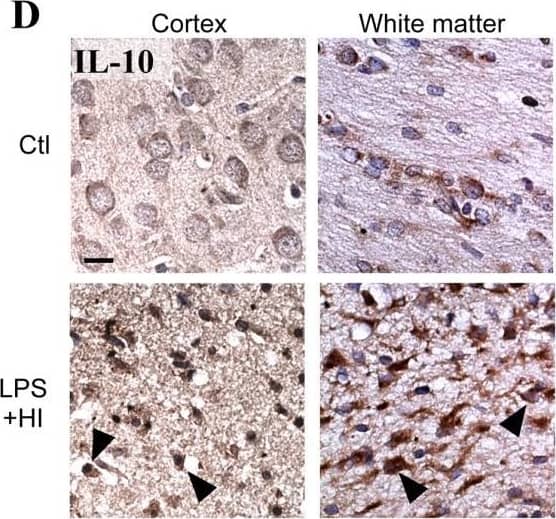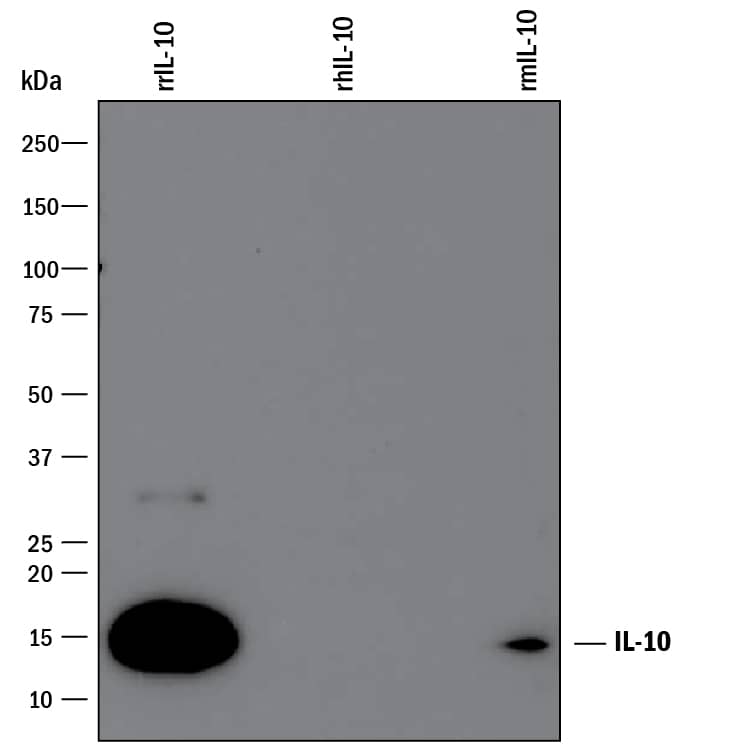Rat IL-10 Antibody
R&D Systems, part of Bio-Techne | Catalog # MAB519

Key Product Details
Validated by
Biological Validation
Species Reactivity
Validated:
Rat
Cited:
Rat
Applications
Validated:
ELISA Capture (Matched Antibody Pair), Western Blot
Cited:
ELISA Development
Label
Unconjugated
Antibody Source
Monoclonal Mouse IgG2B Clone # 67232
Product Specifications
Immunogen
E. coli-derived recombinant rat IL-10
Ser19-Asn178
Accession # P29456
Ser19-Asn178
Accession # P29456
Specificity
Detects rat IL-10 in ELISAs and Western blots. In Western blots, shows approximately 15% cross-reactivity with recombinant mouse IL‑10 and less than 2% cross-reactivity with recombinant human IL-10.
Clonality
Monoclonal
Host
Mouse
Isotype
IgG2B
Scientific Data Images for Rat IL-10 Antibody
Detection of Recombinant Mouse and Rat IL‑10 by Western Blot.
Western blot shows 25 ng of Recombinant Rat IL-10 (Catalog # 522-RLB), Recombinant Human IL-10 (Catalog # 217-IL) and Recombinant Mouse IL-10 (Catalog # 417-ML). PVDF Membrane was probed with 1 µg/mL of Mouse Anti-Rat IL-10 Monoclonal Antibody (Catalog # MAB519) followed by HRP-conjugated Anti-Mouse IgG Secondary Antibody (Catalog # HAF007). A specific band was detected for IL-10 at approximately 15 kDa (as indicated). This experiment was conducted under reducing conditions and using Immunoblot Buffer Group 3.Detection of Rat IL-10 by Immunohistochemistry
Nrg-1 promotes Treg cell response in the injured spinal cord. a, b Representative images of the gating strategy for flow cytometry after singlet selection are provided for vehicle- and Nrg-1-treated groups. c At 3-day post-injury, the number of CD3+CD4+ T cells in the spinal cord was significantly higher in vehicle-treated animals compared to uninjured control group. There was no significant difference in the population of infiltrated helper T cells and the number of FoxP3+ Treg cells (CD3+CD4+FoxP3+) between vehicle- and Nrg-1-treated groups. However, the population of IL-10 producing CD4+ T cells (CD3+CD4+IL-10+) was significantly increased in Nrg-1-treated animals in comparison to vehicle-treated group. d At 7 days post-SCI, despite no significant difference in the total helper and regulatory T cell populations between vehicle- and Nrg-1-treated groups, a significant reduction (1.9-fold) was observed in IFN gamma producing effector T cell population in Nrg-1-treated SCI rats compared to their vehicle-treated counterparts. e At 14 days post-SCI, infiltrated helper T cells reached their lowest level among all examined time-points, and Nrg-1 treatment had no significant effect on the total helper T cell population. IL-10 expressing Treg cells were significantly higher in both vehicle and Nrg-1 injured rats compared to uninjured animals. Nrg-1-treated animals showed a significantly higher number of Treg cells in their spinal cord at 14-day time-point compared to vehicle-treated rats. f However, at chronic (42-day) time-point, the number of T helper cells reached a maximum, with Nrg-1-treated animals harboring a significantly decreased population of CD4+ T-cells in their spinal cord compared to the vehicle-treated group. Most importantly, CD3+CD4+FoxP3+ and CD3+CD4+IL-10+ regulatory T cell populations were significantly increased in Nrg-1-treated groups. g Immunohistochemical images show the presence of Treg cells in the perilesional area (N = 5/group/time-point, *p < 0.05, **p < 0.01, ***p < 0.001, one-way ANOVA followed by Holm-Sidak post hoc test) Image collected and cropped by CiteAb from the following publication (https://jneuroinflammation.biomedcentral.com/articles/10.1186/s12974-018-1093-9), licensed under a CC-BY license. Not internally tested by R&D Systems.Detection of Rat IL-10 by Immunohistochemistry
Nrg-1 treatment promotes Breg cell population following SCI. a Representative images of the gating strategy for flow cytometry of spinal cord are provided. b At 7 days post-injury, the number of CD45RA+ B cells was significantly increased in the spinal cord without any significant difference in the total and regulatory B cell populations between vehicle- and Nrg-1-treated groups. c At 14-day post-SCI, a significant increase in the number of Breg cells was observed in Nrg-1-treated animals compared to vehicle-treated group. d Chronically at 42 days post-SCI, the number of B cells in the spinal cord reached the highest level compared to all earlier time-points. Nrg-1 treatment resulted in a significant increase in the number of infiltrated B cells in the spinal cord and promoted IL-10 expressing Breg cells compared to vehicle treatment. e Immunohistochemical analysis verified the presence of Breg cells in the perilesional area of the injured spinal cord. f Representative images of the gating strategy for flow cytometry of blood are provided. g Analysis of the blood revealed a significant decline in B cell population at 7 days post-SCI without any significant change in the Breg cell population at this time-point. h, i No significant change in total and regulatory B cell populations were observed in the blood at 14- and 42-day time-points. (N = 5/group/time-point, *p < 0.05, **p < 0.01, ***p < 0.001, one-way ANOVA followed by Holm-Sidak post hoc test) Image collected and cropped by CiteAb from the following publication (https://jneuroinflammation.biomedcentral.com/articles/10.1186/s12974-018-1093-9), licensed under a CC-BY license. Not internally tested by R&D Systems.Applications for Rat IL-10 Antibody
Application
Recommended Usage
Western Blot
1 µg/mL
Sample: Recombinant Rat IL‑10 (Catalog # 522-RLB)
Sample: Recombinant Rat IL‑10 (Catalog # 522-RLB)
Rat IL-10 Sandwich Immunoassay
ELISA Capture (Matched Antibody Pair)
Recommended Concentration: 2-8 µg/mL
Use in combination with these reagents:
Use in combination with these reagents:
- Detection Reagent: Rat IL-10 Biotinylated Antibody (Catalog # BAF519)
- Standard: Recombinant Rat IL-10 Protein (Catalog # 522-RL)
Please Note: Optimal dilutions of this antibody should be experimentally determined.
Reviewed Applications
Read 1 review rated 5 using MAB519 in the following applications:
Formulation, Preparation, and Storage
Purification
Protein A or G purified from hybridoma culture supernatant
Reconstitution
Reconstitute at 0.5 mg/mL in sterile PBS. For liquid material, refer to CoA for concentration.
Formulation
Lyophilized from a 0.2 μm filtered solution in PBS with Trehalose. *Small pack size (SP) is supplied either lyophilized or as a 0.2 µm filtered solution in PBS.
Shipping
Lyophilized product is shipped at ambient temperature. Liquid small pack size (-SP) is shipped with polar packs. Upon receipt, store immediately at the temperature recommended below.
Stability & Storage
Use a manual defrost freezer and avoid repeated freeze-thaw cycles.
- 12 months from date of receipt, -20 to -70 °C as supplied.
- 1 month, 2 to 8 °C under sterile conditions after reconstitution.
- 6 months, -20 to -70 °C under sterile conditions after reconstitution.
Background: IL-10
Interleukin 10 (IL-10) is a pleiotropic cytokine that can exert either immunostimulatory or immunosuppressive effects on a variety of cell types. It is produced predominantly by Th2 lymphocytes and other activated lymphoid cells.
Long Name
Interleukin 10
Alternate Names
CSIF, GVHDS, IL10, IL10A, TGIF
Entrez Gene IDs
Gene Symbol
IL10
UniProt
Additional IL-10 Products
Product Documents for Rat IL-10 Antibody
Product Specific Notices for Rat IL-10 Antibody
For research use only
